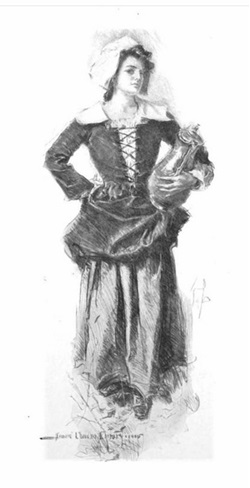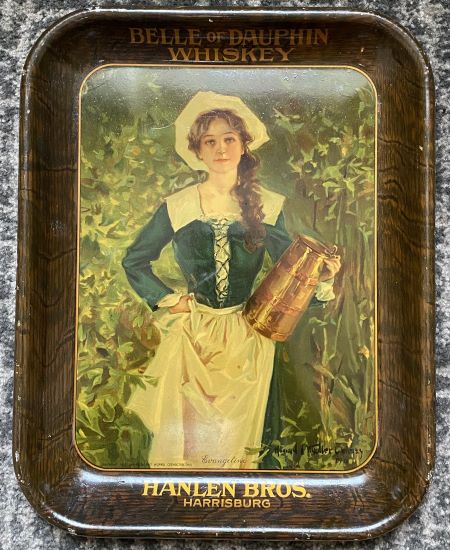The 'Stock' Exchange
American Art Works No. 124 "Evangeline"
American Art Works No. 124 "Evangeline"
Date: 1911 to 1914
Size: 10.5" x 13.5"
Type: Pie
Scarcity: Fairly Common
Value: $$$ to $$$
Condition & Brewer Dependent
Size: 10.5" x 13.5"
Type: Pie
Scarcity: Fairly Common
Value: $$$ to $$$
Condition & Brewer Dependent


Confirmed Brewer used Stock Trays
Non-Beer Related & Non-Tray Uses
General
At first glance “Evangeline” appears to be a milk-maid perhaps from the Netherlands on the late 19th century; however, literate individuals of the early 20th century would have recognized her as the protagonist of Henry Wadsworth’s Evangeline: A Tale of Acadia, an epic poem published in book form in late 1847 which became one of the most famous works in his lifetime and was widely read. It describes the betrothal of a fictional Acadian girl named Evangeline Bellefontaine to her beloved, Gabriel Lajeunesse, and their separation as the British deport the Acadians from Acadie (mainly Nova Scotia and New Brunswick) in the Great Upheaval. The poem then follows Evangeline across the landscapes of America as she spends years in a search for him, some times being near to Gabriel without realizing it. Finally, she settles in Philadelphia and, as an old woman, works as a Sister of Mercy among the poor. While tending the dying during an epidemic she finds Gabriel among the sick, and he dies in her arms.
The Expulsion of the Acadians, also known as the Great Upheaval, the Great Expulsion, the Great Deportation, and the Deportation of the Acadians was the forced removal by the British of the Acadian people from the present-day Canadian Maritime provinces of Nova Scotia, New Brunswick, and Prince Edward Island, and the present-day U.S. state of Maine — causing the death of thousands of people. The Expulsion (1755–1764) occurred during the French and Indian War (the North American theatre of the Seven Years' War) and was part of the British military campaign against New France. The British first deported Acadians to the Thirteen Colonies (those that settled in Louisiana became known as Cajuns), and after 1758, transported additional Acadians to Britain and France.
Longfellow never visited the setting of the true story and so relied heavily on Thomas Chandler Haliburton's An Historical and Statistical Account of Nova Scotia and other books for further background information. He noted his reliance on other sources in his journal on January 7, 1847: "Went to the library and got Watson's Annals of Philadelphia, and the Historical Collections of Pennsylvania. Also, Darby's Geographical Description of Louisiana. These books must help me through the last part of Evangeline, so far as facts and local coloring go.” Later scholarship reveals that Longfellow overly romanticized the simple, rustic life in Acadia and got many of the historical details of the expulsion wrong
In the poem Evangeline is the daughter of Benedict Bellefontaine, the wealthiest farmer of Grand-Pré (an actual village in Nova Scotia where a statue of Evangeline was erected) and described as “the pride of the village.” The lines that introduce her clarifies the image on the design of this stock tray:
Fair was she to behold, that maiden of seventeen summers.
Black were her eyes as the berry that grows on the thorn by the wayside,
Black, yet how softly they gleamed beneath the brown shade of her tresses!
Sweet was her breath as the breath of kine that feed in the meadows.
When in the harvest heat she bore to the reapers at noontide
Flagons of home-brewed ale, ah! fair in sooth was the maiden”
So instead of a milk maid, we have a young woman carrying beer to the hardworking fieldhands doing the harvesting, an understandably suitable design for brewers. For those not familiar, a flagon is a large leather, metal, glass, plastic or ceramic vessel, used for drink, whether for water, ale, or another liquid. A flagon is typically of about 2 imperial pints in volume, and it has either a handle, or one or two rings at the neck. Sometimes the neck has a large flange at the top rather than rings. The name comes from the same origin as the word "flask".
At first glance “Evangeline” appears to be a milk-maid perhaps from the Netherlands on the late 19th century; however, literate individuals of the early 20th century would have recognized her as the protagonist of Henry Wadsworth’s Evangeline: A Tale of Acadia, an epic poem published in book form in late 1847 which became one of the most famous works in his lifetime and was widely read. It describes the betrothal of a fictional Acadian girl named Evangeline Bellefontaine to her beloved, Gabriel Lajeunesse, and their separation as the British deport the Acadians from Acadie (mainly Nova Scotia and New Brunswick) in the Great Upheaval. The poem then follows Evangeline across the landscapes of America as she spends years in a search for him, some times being near to Gabriel without realizing it. Finally, she settles in Philadelphia and, as an old woman, works as a Sister of Mercy among the poor. While tending the dying during an epidemic she finds Gabriel among the sick, and he dies in her arms.
The Expulsion of the Acadians, also known as the Great Upheaval, the Great Expulsion, the Great Deportation, and the Deportation of the Acadians was the forced removal by the British of the Acadian people from the present-day Canadian Maritime provinces of Nova Scotia, New Brunswick, and Prince Edward Island, and the present-day U.S. state of Maine — causing the death of thousands of people. The Expulsion (1755–1764) occurred during the French and Indian War (the North American theatre of the Seven Years' War) and was part of the British military campaign against New France. The British first deported Acadians to the Thirteen Colonies (those that settled in Louisiana became known as Cajuns), and after 1758, transported additional Acadians to Britain and France.
Longfellow never visited the setting of the true story and so relied heavily on Thomas Chandler Haliburton's An Historical and Statistical Account of Nova Scotia and other books for further background information. He noted his reliance on other sources in his journal on January 7, 1847: "Went to the library and got Watson's Annals of Philadelphia, and the Historical Collections of Pennsylvania. Also, Darby's Geographical Description of Louisiana. These books must help me through the last part of Evangeline, so far as facts and local coloring go.” Later scholarship reveals that Longfellow overly romanticized the simple, rustic life in Acadia and got many of the historical details of the expulsion wrong
In the poem Evangeline is the daughter of Benedict Bellefontaine, the wealthiest farmer of Grand-Pré (an actual village in Nova Scotia where a statue of Evangeline was erected) and described as “the pride of the village.” The lines that introduce her clarifies the image on the design of this stock tray:
Fair was she to behold, that maiden of seventeen summers.
Black were her eyes as the berry that grows on the thorn by the wayside,
Black, yet how softly they gleamed beneath the brown shade of her tresses!
Sweet was her breath as the breath of kine that feed in the meadows.
When in the harvest heat she bore to the reapers at noontide
Flagons of home-brewed ale, ah! fair in sooth was the maiden”
So instead of a milk maid, we have a young woman carrying beer to the hardworking fieldhands doing the harvesting, an understandably suitable design for brewers. For those not familiar, a flagon is a large leather, metal, glass, plastic or ceramic vessel, used for drink, whether for water, ale, or another liquid. A flagon is typically of about 2 imperial pints in volume, and it has either a handle, or one or two rings at the neck. Sometimes the neck has a large flange at the top rather than rings. The name comes from the same origin as the word "flask".
Down the long street she passed, with her chaplet of beads and her missal,
Wearing her Norman cap and her kirtle of blue, and the ear-rings,
Brought in the olden time from France, and since, as an heirloom,
Handed down from mother to child, through long generations.
The design is signed by Howard Chandler Christy (1872 –1952) was an American artist and illustrator. Famous for the "Christy Girl" – a colorful and illustrious successor to the "Gibson Girl" – Christy was later widely known for his iconic WWI military recruitment and Liberty loan posters, along with his 1940 masterpiece titled, Scene at the Signing of the Constitution of the United States, which is installed along the east stairwell of the United States Capitol. By 1938, Time magazine proclaimed Christy "the most commercially successful U.S. artist. Among the illustrations from the Bobbs-Merrill version of Evangeline - is this image clearly the inspiration for this version on this design?
Sahling has no entry in his workbook for this design.
Size & Shape and Advertising Placement
All tray versions that we have seen are small oblongs (11x14); the only other format we’ve seen this design is as a tin over cardboard sign (and only once as we recall). Like other small oblongs of this era, rims are woodgrain with gold advertising text. Some examples have text or symbols in gold on the flagon she is carrying.
Hager & Price
Hager does briefly discuss this design to speculate that it may be stock number 108, 109, 110 or 112 and that trays in this range often had a 1910 copyright date. Given that he didn’t have a definitive answer he did not include it in his date of introduction table or in his catalog. Since he had not identified No. 108 (Tokio) or No. 110 (Rose of Killarney), not associated No. 112 with Ioneta, and No. 109 remains unknown, this conjecture makes sense given that there was a burst of small oblong designs in this timeframe.
Wearing her Norman cap and her kirtle of blue, and the ear-rings,
Brought in the olden time from France, and since, as an heirloom,
Handed down from mother to child, through long generations.
The design is signed by Howard Chandler Christy (1872 –1952) was an American artist and illustrator. Famous for the "Christy Girl" – a colorful and illustrious successor to the "Gibson Girl" – Christy was later widely known for his iconic WWI military recruitment and Liberty loan posters, along with his 1940 masterpiece titled, Scene at the Signing of the Constitution of the United States, which is installed along the east stairwell of the United States Capitol. By 1938, Time magazine proclaimed Christy "the most commercially successful U.S. artist. Among the illustrations from the Bobbs-Merrill version of Evangeline - is this image clearly the inspiration for this version on this design?
Sahling has no entry in his workbook for this design.
Size & Shape and Advertising Placement
All tray versions that we have seen are small oblongs (11x14); the only other format we’ve seen this design is as a tin over cardboard sign (and only once as we recall). Like other small oblongs of this era, rims are woodgrain with gold advertising text. Some examples have text or symbols in gold on the flagon she is carrying.
Hager & Price
Hager does briefly discuss this design to speculate that it may be stock number 108, 109, 110 or 112 and that trays in this range often had a 1910 copyright date. Given that he didn’t have a definitive answer he did not include it in his date of introduction table or in his catalog. Since he had not identified No. 108 (Tokio) or No. 110 (Rose of Killarney), not associated No. 112 with Ioneta, and No. 109 remains unknown, this conjecture makes sense given that there was a burst of small oblong designs in this timeframe.


Click the Picture to Return to Meek & Beach Stock Catalog Page







